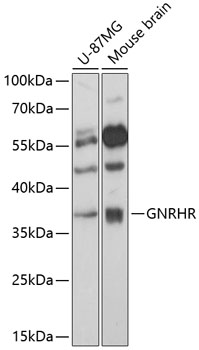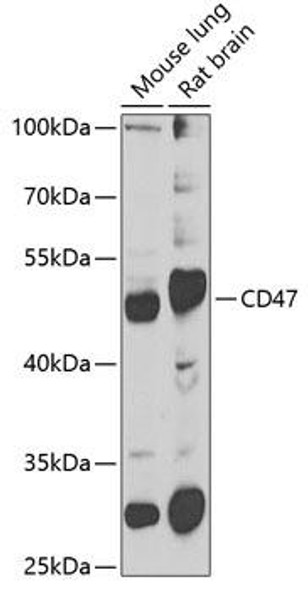Cell Biology Antibodies 5
Anti-GNRHR Antibody (CAB14487)
- SKU:
- CAB14487
- Product Type:
- Antibody
- Reactivity:
- Human
- Reactivity:
- Mouse
- Host Species:
- Rabbit
- Isotype:
- IgG
- Antibody Type:
- Polyclonal Antibody
- Research Area:
- Cell Biology
Description
| Antibody Name: | Anti-GNRHR Antibody |
| Antibody SKU: | CAB14487 |
| Antibody Size: | 20uL, 50uL, 100uL |
| Application: | WB |
| Reactivity: | Human, Mouse |
| Host Species: | Rabbit |
| Immunogen: | A synthetic peptide corresponding to a sequence within amino acids 200-300 of human GNRHR (NP_000397.1). |
| Application: | WB |
| Recommended Dilution: | WB 1:500 - 1:2000 |
| Reactivity: | Human, Mouse |
| Positive Samples: | U-87MG, Mouse brain |
| Immunogen: | A synthetic peptide corresponding to a sequence within amino acids 200-300 of human GNRHR (NP_000397.1). |
| Purification Method: | Affinity purification |
| Storage Buffer: | Store at -20'C. Avoid freeze / thaw cycles. Buffer: PBS with 0.02% sodium azide, 50% glycerol, pH7.3. |
| Isotype: | IgG |
| Sequence: | CSFS QWWH QAFY NFFT FSCL FIIP LFIM LICN AKII FTLT RVLH QDPH ELQL NQSK NNIP RARL KTLK MTVA FATS FTVC WTPY YVLG IWYW FDPE MLNR L |
| Gene ID: | 2798 |
| Uniprot: | P30968 |
| Cellular Location: | Cell membrane, Multi-pass membrane protein |
| Calculated MW: | 27kDa/37kDa |
| Observed MW: | 38kDa |
| Synonyms: | GNRHR, GNRHR1, GRHR, HH7, LHRHR, LRHR |
| Background: | This gene encodes the receptor for type 1 gonadotropin-releasing hormone. This receptor is a member of the seven-transmembrane, G-protein coupled receptor (GPCR) family. It is expressed on the surface of pituitary gonadotrope cells as well as lymphocytes, breast, ovary, and prostate. Following binding of gonadotropin-releasing hormone, the receptor associates with G-proteins that activate a phosphatidylinositol-calcium second messenger system. Activation of the receptor ultimately causes the release of gonadotropic luteinizing hormone (LH) and follicle stimulating hormone (FSH). Defects in this gene are a cause of hypogonadotropic hypogonadism (HH). Alternative splicing results in multiple transcript variants encoding different isoforms. More than 18 transcription initiation sites in the 5' region and multiple polyA signals in the 3' region have been identified for this gene. |
| UniProt Protein Function: | GNRHR: Receptor for gonadotropin releasing hormone (GnRH) that mediates the action of GnRH to stimulate the secretion of the gonadotropic hormones luteinizing hormone (LH) and follicle- stimulating hormone (FSH). This receptor mediates its action by association with G-proteins that activate a phosphatidylinositol- calcium second messenger system. Isoform 2 may act as an inhibitor of GnRH-R signaling. Defects in GNRHR are a cause of idiopathic hypogonadotropic hypogonadism (IHH). IHH is defined as a deficiency of the pituitary secretion of follicle-stimulating hormone and luteinizing hormone, which results in the impairment of pubertal maturation and of reproductive function. Defects in GNRHR are a cause of fertile eunuch syndrome (FEUNS). Fertile eunuch syndrome is a mild phenotypic form of HH going with the presence of normal testicular size and some degree of spermatogenesis. Belongs to the G-protein coupled receptor 1 family. 2 isoforms of the human protein are produced by alternative splicing. |
| UniProt Protein Details: | Protein type:Receptor, GPCR; GPCR, family 1; Membrane protein, multi-pass; Membrane protein, integral Chromosomal Location of Human Ortholog: 4q21.2 Cellular Component: membrane; integral to plasma membrane; plasma membrane Molecular Function:gonadotropin-releasing hormone receptor activity; peptide binding Biological Process: G-protein coupled receptor protein signaling pathway; multicellular organismal development Disease: Hypogonadotropic Hypogonadism 7 With Or Without Anosmia |
| NCBI Summary: | This gene encodes the receptor for type 1 gonadotropin-releasing hormone. This receptor is a member of the seven-transmembrane, G-protein coupled receptor (GPCR) family. It is expressed on the surface of pituitary gonadotrope cells as well as lymphocytes, breast, ovary, and prostate. Following binding of gonadotropin-releasing hormone, the receptor associates with G-proteins that activate a phosphatidylinositol-calcium second messenger system. Activation of the receptor ultimately causes the release of gonadotropic luteinizing hormone (LH) and follicle stimulating hormone (FSH). Defects in this gene are a cause of hypogonadotropic hypogonadism (HH). Alternative splicing results in multiple transcript variants encoding different isoforms. More than 18 transcription initiation sites in the 5' region and multiple polyA signals in the 3' region have been identified for this gene. [provided by RefSeq, Jul 2008] |
| UniProt Code: | P30968 |
| NCBI GenInfo Identifier: | 399777 |
| NCBI Gene ID: | 2798 |
| NCBI Accession: | P30968.1 |
| UniProt Secondary Accession: | P30968,O75793, Q14D13, Q92644, |
| UniProt Related Accession: | P30968 |
| Molecular Weight: | 328 |
| NCBI Full Name: | Gonadotropin-releasing hormone receptor |
| NCBI Synonym Full Names: | gonadotropin-releasing hormone receptor |
| NCBI Official Symbol: | GNRHR |
| NCBI Official Synonym Symbols: | HH7; GRHR; LRHR; LHRHR; GNRHR1 |
| NCBI Protein Information: | gonadotropin-releasing hormone receptor; gnRH-R; gnRH receptor; luliberin receptor; type I GnRH receptor; leutinizing-releasing hormone receptor; leutinizing hormone releasing horomone receptor; gonadotropin-releasing hormone (type 1) receptor 1 |
| UniProt Protein Name: | Gonadotropin-releasing hormone receptor |
| Protein Family: | Gonadotropin-releasing hormone receptor |
| UniProt Gene Name: | GNRHR |
| UniProt Entry Name: | GNRHR_HUMAN |
View AllClose







